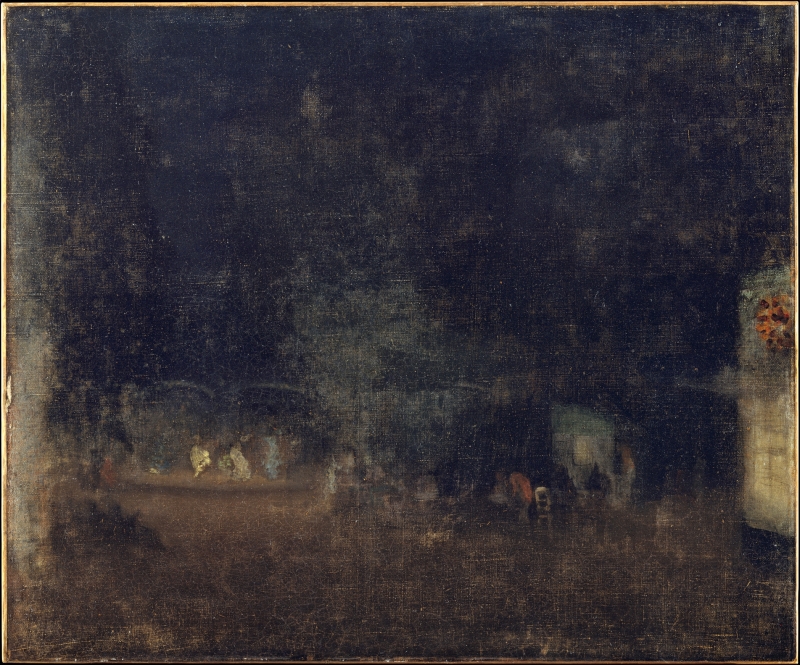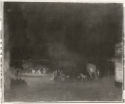Technique
It is thinly painted, with a few highlights of thicker paint for the fireworks. Sutton calls the painting 'revolutionary by reason of its almost complete denial of colouristic possibilities and the reduction of light to a bare minimum', and describes the brushstrokes that suggest the figures 'summary dashes of pigment.' 1
Conservation History
In 1892 Whistler sent instructions to David Croal Thomson (1855-1930) of the Goupil Gallery to send one of his Cremorne Nocturnes – possibly Nocturne in Black and Gold: The Gardens [YMSM 166] – to the picture restorer Stephen Richards (1844-1900) in London, and then to him in Paris, for treatment:
'Nocturne - Cremorne. The large one that was sent down to Bond Street but not exhibited - I should like Richards to take all the varnish off - with great care and tenderness at once - and then leaving it unvarnished, (for me to paint upon) send it ...to Joyant here, who will deliver them to me.' 2
He wrote again on 6 June 1892:
'You remember also that I told you to let Richards wash the large Cremorne Nocturne (that was brought to the Gallery but not exhibited) and take off any varnish, if he found any - and then send it to me without revarnishing so that I might paint upon it.' 3
When Nocturne in Black and Gold: The Gardens arrived at the Metropolitan Museum of Art in 1906 it was already badly cracked. 4 It has darkened over the years through irreversible chemical processes. The colours have now virtually disappeared, a loss attributed, by Roger Elliot Fry (1866-1934) in 1909, to Whistler's use of bitumen. 5
In 1983 the museum conservator noted that there were drying cracks and burns that could have resulted from the lining of the canvas, and that the natural darkening of the paint had probably been augmented by chemicals used in earlier restorations. 6
Frame
A Grau Whistler frame, which was originally signed by Frederick Henry Grau (1859-1892), but this signature has been rubbed out. The label of Thomas Agnew & Sons on the verso confirms that this frame was on the painting when it was sold in 1902.
Notes:
1: Sutton 1966 B [more] , p. 24.
4: Walter Gay admitted that in 1905 there were fine cracks but 'no white showing underneath' and he suggested that the voyage to America might have caused further cracking (letter, 13 November 1906, Metropolitan Museum of Art Archives).
5: Quoted by Sutton, Denys (ed.), The Letters of Roger Fry, 2 vols., London, 1972, pp. 310, 312.
6: D. Dwyer, painting conservator, Metropolitan Museum of Art, 21 March 1983, quoted in Spassky, Natalie, with Linda Bantel, Doreen Bolger Burke, Meg Perlman, and Amy L. Walsh, American Paintings in The Metropolitan Museum of Art, vol. 2, A Catalogue of Works by Artists Born between 1816 and 1845 , New York, 1985, pp. 370-73, at p. 373.
Last updated: 19th April 2021 by Margaret







